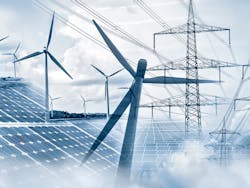The recent Texas disaster has accelerated the conversation about creating a clean, resilient grid.
But much work needs to be done to achieve that goal, according to three speakers who participated in a the recent Pecan Street webinar, “Addressing Technology Roadblocks to Clean Energy Adoption.” Pecan Street conducts research aimed at advancing climate solutions.
“The events in Texas have driven energy headlines and accelerated the conversation about a clean grid that is also resilient,” said Neil Chatterjee, commissioner of the Federal Energy Regulatory Commission (FERC).
Roadblocks include policies that incentivize fossil fuel use, market barriers, transmission constraints and a need for smart meters and data about issues such as weather, according to the speakers.
The speakers said that the most cost-effective path toward a clean, resilient grid is unclear.
“The desire to change is there, but the most cost-effective path forward is not clearly defined. Each region has to define its unique path,” said Rory Christian, principal, Concentric Consulting Group and board vice-chair of WeAct for Environmental Justice. But the industry needs to make the right investments now to move toward a decentralized grid that features power and services from customers, he added.
Pecan Street also released a white paper, “Technology Roadblocks to the Clean Energy Future,” that identified obstacles to creating a clean and resilient grid. It focuses on the need to collect more energy data, ensure interoperability among distributed energy resources (DERs), and provide technology that can optimize systems — rather than specializing in one function. In addition, gathering data related to weather, market, emissions, customer location and lifestyles is important, the white paper said.
For its part, FERC needs to focus on reducing market barriers and enabling new players and technology to compete, said Chatterjee.
Stunning action by FERC
Key to moving toward these goals are the recent FERC Orders 841 and 2222, said Chatterjee. FERC Order 2222 lays the groundwork for aggregated DERs to compete alongside traditional power plants and other grid resources in wholesale markets. Order 841 aims to eliminate barriers that prevent energy storage operators and owners from participating in wholesale capacity, energy and ancillary services markets.
“These sound wonky but are truly stunning in their power to catapult us forward. This year, we will focus on these orders, which will enable DERs to compete with traditional resources,” Chatterjee said. “This will change how Americans generate and consume energy.”
To make the most of these FERC orders in the new electric world, aggregators will have to pitch to businesses and residents the business case for installing and owning rooftop solar, EV charging and other DERs, which can generate significant revenues through aggregation, he added.
Another FERC goal is ensuring enough transmission resources to handle the DERs that are being connected to the grid, Chatterjee said.
“Transmission will be central to the future, and it really will take a ‘whole of government’ approach to address transmission,” he said. “When you get into siting, transmission is multiple balls of yarn intertwined. You pull out one strand and it pulls out others.”
According to Christian of Concentric Consulting Group, policies that incentivize DERs are important, but additional policy work is needed to address entrenched practices and policies that incentivize fossil fuel use.
“Many state policies serve to hinder progress toward electrification and more robust electric markets,” he said. “The system is complicated, and change is hard.”
He also pointed out the need to ensure DERs are accessible to marginalized communities. California and New York are involving the environmental justice community in the decision making process early, he said, and should be role models.
Joshua Rhodes, postdoctoral researcher for Webber Energy Group/Energy Institute at the University of Texas at Austin, focused on the need for more data, echoing a recommendation by Pecan Street’s white paper.
Why smart meters didn’t help in Texas disaster
“Any engineer will say the more data we have, the better off we will be. We need to make informed choices,” Rhodes said. Texas did a smart meter rollout a few years ago, but it didn’t help during the recent crisis, he noted. Smart meters could have helped by focusing on cutting power to specific homes or businesses in ways that kept power flowing for essential services. “The smart meters should have been able to cut off power to individual homes instead of entire circuits. It could have been more surgical, even with current technology,” he said.
Christian also pointed to the need for data, saying that an important first step for homeowners is knowing what’s going on with the grid. In the past — and even now — customers have to call utilities to confirm that there’s an outage and obtain information about what caused it.
“We need smart meters and infrastructure behind the meters so customers can see what’s going on behind their meters without having to pick up a phone,” said Christian.
Chatterjee concluded that it’s important to invest in innovative new technologies and find ways to deliver more affordable electricity in a reliable and clean way. Working toward these changes is a challenge, but it’s an exciting challenge, he said.
“I’m looking forward to the challenge and what the future will hold,” he added.
Learn how microgrids help create a resilient grid. Join us this spring for Microgrid 2021: The World Awakens to Microgrids. Participation is free for those who register in advance.








